Paul Bishop's Blog, page 24
July 19, 2017
BRIT SPY—THE BARON
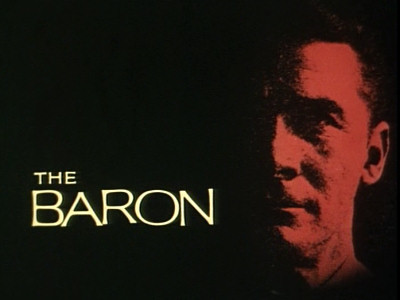 BRIT SPY—THE BARON
BRIT SPY—THE BARONBritish crime writer John Creasey wrote more than six hundred novels using twenty-eight different pseudonyms. As Anthony Morton, he created the character of John Mannering, better known as The Baron, a not quite reformed jewel thief turned antiques dealer and adventurer. Between 1937 and 1961, Creasey wrote more than thirty novels featuring The Baron, making him—along with The Toff—one of Creasey’s most popular characters.
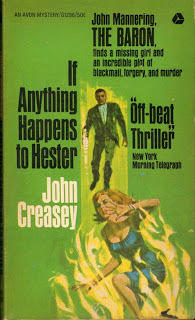
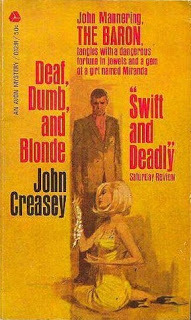 In the mid-sixties, British television production and distribution company ITC produced a number of European based action shows starring Americans in the lead role. This practice helped ITC sell their shows in America and other syndicated markets demanding American actors. Robert Vaughn (The Protectors), Gene Barry (The Adventurer), Richard Bradford (Man In A Suitcase) and other recognizably American actors were happy to extend their reach to international audiences while also playing to those back home—including Steve Forrest as The Baron.
In the mid-sixties, British television production and distribution company ITC produced a number of European based action shows starring Americans in the lead role. This practice helped ITC sell their shows in America and other syndicated markets demanding American actors. Robert Vaughn (The Protectors), Gene Barry (The Adventurer), Richard Bradford (Man In A Suitcase) and other recognizably American actors were happy to extend their reach to international audiences while also playing to those back home—including Steve Forrest as The Baron. 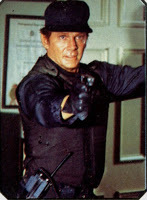 In 1965, under ITC’s guidance, the originally British John Mannering became an American. Steve Forrest (best known for his later American role as Lt. Hondo Harrelson in S.W.A.T.) was cast as The Baron, going on to film thirty episodes of the show. One of the first color series on British television, The Baron made Forrest an internationally well-known figure.
In 1965, under ITC’s guidance, the originally British John Mannering became an American. Steve Forrest (best known for his later American role as Lt. Hondo Harrelson in S.W.A.T.) was cast as The Baron, going on to film thirty episodes of the show. One of the first color series on British television, The Baron made Forrest an internationally well-known figure.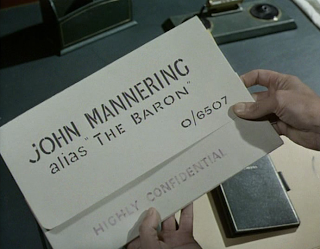 In his television incarnation, The Baron not only became an American antiques dealer, but all mention of his days as a cat burglar-reformed or not—disappeared with his British passport. Instead, he occasionally finds himself acting as an informal undercover agent for Templeton-Green, head of British Diplomatic Intelligence. Mannering was assisted in his antiques business by David Marlowe. However, under pressure from ABC, the American broadcast network carrying the show, Marlowe was replaced by the much more winsome Cordelia Winfield.
In his television incarnation, The Baron not only became an American antiques dealer, but all mention of his days as a cat burglar-reformed or not—disappeared with his British passport. Instead, he occasionally finds himself acting as an informal undercover agent for Templeton-Green, head of British Diplomatic Intelligence. Mannering was assisted in his antiques business by David Marlowe. However, under pressure from ABC, the American broadcast network carrying the show, Marlowe was replaced by the much more winsome Cordelia Winfield.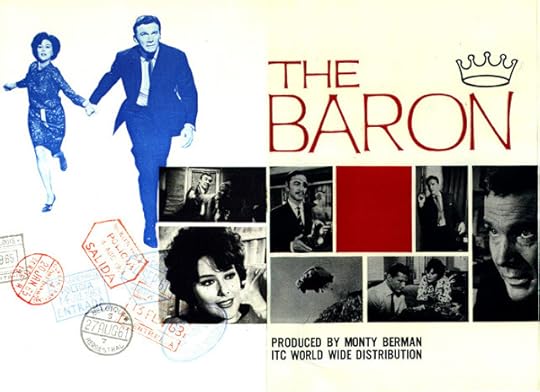 The American network also required more changes. British vernacular, such as petrol, car boot, car bonnet, and more, had to be dubbed over with the appropriate American terms. And due to the cigarette company sponsorship of many American network shows, a mandate was established insisting characters were allowed to light up only in moments of leisure, never when they were frightened or under duress.
The American network also required more changes. British vernacular, such as petrol, car boot, car bonnet, and more, had to be dubbed over with the appropriate American terms. And due to the cigarette company sponsorship of many American network shows, a mandate was established insisting characters were allowed to light up only in moments of leisure, never when they were frightened or under duress.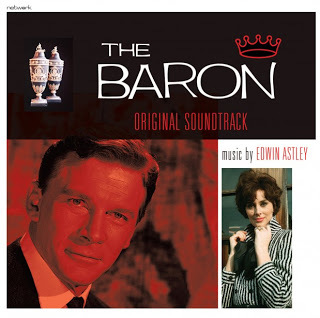 There were more changes. Having cast Texan Steve Forrest in the role of John Mannering, the producers claimed he was nicknamed The Baron for the 200,000 acre Lone Star State cattle ranch owned by his grandfather. In an early episode of the show Mannering is established as having been a US Army Captain in World War II, serving in the Monuments, Fine Arts, and Archives program, where he recovered art works from the Nazis.
There were more changes. Having cast Texan Steve Forrest in the role of John Mannering, the producers claimed he was nicknamed The Baron for the 200,000 acre Lone Star State cattle ranch owned by his grandfather. In an early episode of the show Mannering is established as having been a US Army Captain in World War II, serving in the Monuments, Fine Arts, and Archives program, where he recovered art works from the Nazis.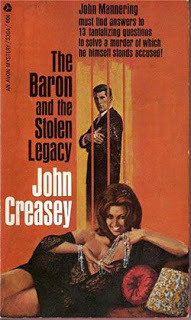 In the early books of the original series, Mannering gets married and remains so for the rest of his adventures. For TV, however, it wouldn’t do for a charter member of the jet set to be in the midst of domestic bliss. As a result, the character was returned to bachelorhood, much to the delight of the female character populating the show. Much of this set-up was to make The Baron as much like The Saint as possible in an effort to tag onto the success of Simon Templar’s coattails.
In the early books of the original series, Mannering gets married and remains so for the rest of his adventures. For TV, however, it wouldn’t do for a charter member of the jet set to be in the midst of domestic bliss. As a result, the character was returned to bachelorhood, much to the delight of the female character populating the show. Much of this set-up was to make The Baron as much like The Saint as possible in an effort to tag onto the success of Simon Templar’s coattails. 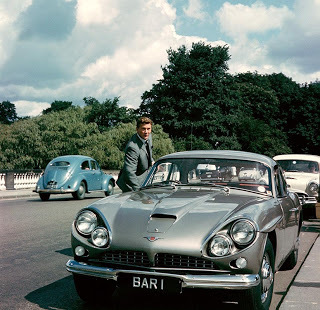 Like The Saint, The Baron even had his own trademark car, a silver Jensen CV-8 Mk II with the registration BAR 1. However, unlike The Saint’s less outlandish Volvo, The Baron’s elitist Jensen didn’t provide the same sales boost for dealerships.
Like The Saint, The Baron even had his own trademark car, a silver Jensen CV-8 Mk II with the registration BAR 1. However, unlike The Saint’s less outlandish Volvo, The Baron’s elitist Jensen didn’t provide the same sales boost for dealerships. Most episodes of The Baron were written by ITC stalwarts Dennis Spooner and Terry Nation (the man behind the creation of the Daleks). Other scripts were written by Brian Clemens (The Avengers) under the pseudonym Tony O’Grady. The show also shared production crew members and guest stars with many other ongoing ITC shows.
While The Baronhad his reputation as a jet-setter to uphold, filming of the show never left England. Along with sharing stand-in foreign locations with other ITC shows of the era, the backlot of Elstree Studios was alternately transformed into Mannering's antiques shop, a Mexican town, a Parisian nightclub, an East European police station, and many more exoticlocations.
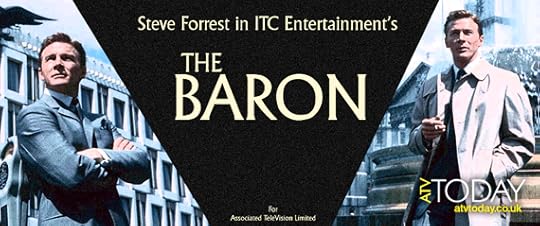 Like many of the shows from the spy crazy era of the sixties (such as The Man From U.N.C.L.E., The Saint, Man In A Suitcase, The Champions, and Danger Man), feature films for European release were produced by re-editing and combining two part episodes from the shows. All part of ITC generating as much money as possible from its expanding collection of spy and adventure shows.
Like many of the shows from the spy crazy era of the sixties (such as The Man From U.N.C.L.E., The Saint, Man In A Suitcase, The Champions, and Danger Man), feature films for European release were produced by re-editing and combining two part episodes from the shows. All part of ITC generating as much money as possible from its expanding collection of spy and adventure shows.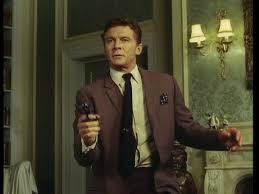 The Baron holds up well when viewing episodes on DVD, but remains an underrated show from the time period. Steve Forrest was a strong lead as John Mannering, American antique dealer living in London. The conceit of The Baron using his antique art expertise to freelance for British Intelligence was a viable concept. Ultimately, however, The Baron tried too hard to be a clone of The Saint and, in the process, failed to be distinct enough to have a longer run.
The Baron holds up well when viewing episodes on DVD, but remains an underrated show from the time period. Steve Forrest was a strong lead as John Mannering, American antique dealer living in London. The conceit of The Baron using his antique art expertise to freelance for British Intelligence was a viable concept. Ultimately, however, The Baron tried too hard to be a clone of The Saint and, in the process, failed to be distinct enough to have a longer run.
Published on July 19, 2017 14:51
BALANCING TAFFIN
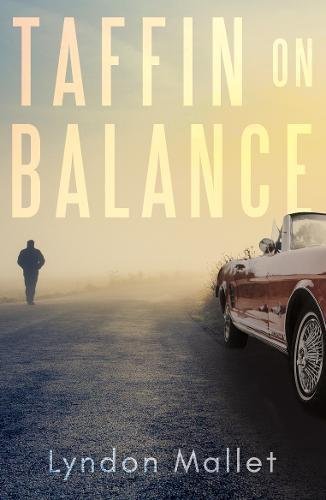 BALANCING TAFFIN
BALANCING TAFFINJournalist, road manager of a flying circus, cartoonist, and advertising copywriter, Lyndon Mallet is poised to bring back one of the most iconic characters in the hardboiled Brit Grit genre—Taffin. A savvy and savage tough-guy debt collector, Taffin made his debut in 1980 in two paperback original novels, Taffin and Taffin’s First Law, published back to back by British publisher New English Library (NEL).
 Taffin is a tough-guy debt collector who when not working or teaching young tearaways the fine art of intimidation, is happy to spend his time reading books on philosophy and theory. He is a big fish in the very little pond known as Lasherham. He goes about his business in a quiet, polite manner. Nobody, however, wants a second visit from Taffin because it usually involves excruciating pain. Mark Taffin is decidedly overweight and unattractive, he’s a thug and a loner who prefers psychological manipulation to dealing out broken bones—unless necessary. He is the definition of menace.
Taffin is a tough-guy debt collector who when not working or teaching young tearaways the fine art of intimidation, is happy to spend his time reading books on philosophy and theory. He is a big fish in the very little pond known as Lasherham. He goes about his business in a quiet, polite manner. Nobody, however, wants a second visit from Taffin because it usually involves excruciating pain. Mark Taffin is decidedly overweight and unattractive, he’s a thug and a loner who prefers psychological manipulation to dealing out broken bones—unless necessary. He is the definition of menace. When asked what got him started as a writer, Mallet states, it was a venerable Olympia typewriter on a table beside my father’s easel. It was black and upright and I was allowed to thump on the keys so long as there was paper in it. My father used it for typing the captions which he pasted on to his cartoons. Macs, Photoshop and Indesign were improbable sci-fi back then.
Speaking about his Taffin novels, Lyndon gives this rundown: Taffin is about a small town debt collector who becomes indispensable when his community is threatened by a ruthless developer. Taffin himself—a looming, expressionless, monosyllabic character—is a mixture of two people I know, or have known, in real life. I don’t believe anyone invents a character from nothing. Taffin is the product of some personal experience of mine.
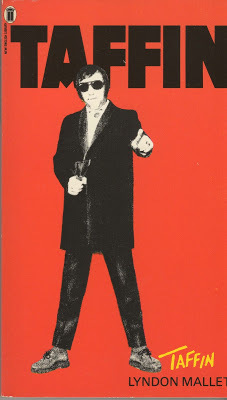 When I write for him, I know what I’m talking about. He is not the average thug. Despite an intimidating demeanor, he prefers mind-games to physical violence when it comes to applying pressure. The story suggests that when the law is powerless, the will of the public can sometimes prevail. So far, so optimistic; but there is a darker subtext: be careful what you wish for—it may come at a price you’re not willing to pay. Taffin understands this, knowing if he does what everyone wants, they will eventually reject him for it. ‘If I took this job,’ he tells the villagers, ‘you’d be begging me to stop within a week.’
When I write for him, I know what I’m talking about. He is not the average thug. Despite an intimidating demeanor, he prefers mind-games to physical violence when it comes to applying pressure. The story suggests that when the law is powerless, the will of the public can sometimes prevail. So far, so optimistic; but there is a darker subtext: be careful what you wish for—it may come at a price you’re not willing to pay. Taffin understands this, knowing if he does what everyone wants, they will eventually reject him for it. ‘If I took this job,’ he tells the villagers, ‘you’d be begging me to stop within a week.’ The sequel, Taffin’s First Law, was commissioned and written within four months of the first book appearing. Carola Edmonds, my Editor at New English Library, felt we should address some questions left unanswered in the first Taffin story as fast as possible—and anyway, I was on a roll. The idea of a wealthy American trying to buy a deconsecrated English village church had a certain appeal.
There is plenty of precedent—London Bridge was sold and reassembled at Lake Havasu City, Arizona. And it seemed to me if a clandestine syndicate tried to sell the church in Taffin’s home village, the locals would have something to say about it.
But before they could turn to Taffin, I would have to bring him back from exile, and there’s no better template for that than ‘The Return of Sherlock Holmes’. Taffin—the dead man—makes his reappearance sitting in the pub…and they’ve all come to look…
In Ask Taffin Nicely, time has passed and Taffin has grown up. If he ever thought of himself as a hero, he doesn’t now. But the locals still find in his enigmatic nature something they need when they suspect their village is harboring a child murderer.
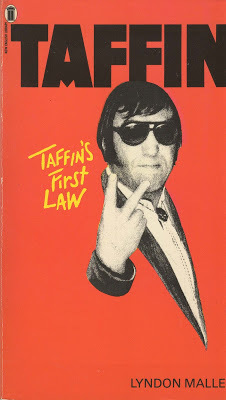 For the first time we see Taffin working in parallel—but not in harmony—with the police. There is a prime suspect, but Taffin has his doubts. Not content to go along with the popular view he applies his mind to an alternative theory. What he finds nearly costs him his life.
For the first time we see Taffin working in parallel—but not in harmony—with the police. There is a prime suspect, but Taffin has his doubts. Not content to go along with the popular view he applies his mind to an alternative theory. What he finds nearly costs him his life.Later this year, after a twenty-five year hiatus, Taffin will be flexing his muscles again in Taffin On Balance. This time his mandate is to protect the village where he lives when it is threatened by the planned incursion of a high speed rail route known as StarTrack.
In anticipation of this new Taffin chapter, Lyndon Mallet has agreed to go under the bright lights of the interrogation room—an arena where Taffin himself would feel quite comfortable.
********What details would be essential if Interpol issued an international fugitive warrant for Lyndon Mallet? They would be looking for a six foot, soft spoken, graying Brit, bearded or clean-shaven according to mood. More to the point, my wife and family would immediately want to know why Interpol was looking for me and I wouldn’t want to be the agent they confronted. My wife’s first question would be, ‘Have you tried the Cross Keys or the White Lion – if not, why not?’ At one time she might have suggested the nearest airfield. All that aside, Interpol would have to face the fact that I live a life of blameless domesticity in rural surroundings of matchless charm. If I have a double anywhere (other than in one of the aforementioned pubs) that’s who they’re looking for. Mistaken identity springs to mind. What were your earliest reading and writing influences? Roald Dahl. Reading him in my teens taught me to write about subjects close to home. He lived in my village and much later I had the privilege of knowing him (we shared a book signing session once in a local bookshop). His grave is on the hill half a mile from where I’m writing this. Other major influences have been Ray Bradbury, George MacDonald Fraser, Patrick O’Brien, Arthur Conan Doyle, J. P. Donleavy, and Rudyard Kipling. How much influence did your father’s creative output have on your career choices? Considerable. My father was a cartoonist with an independent spirit who never consciously tried to steer me in any particular direction. At the same time he managed to convey a sense of the discipline you need to go your own way. I learnt to draw by watching him at work. Any questions, the answer was always there. So was the typewriter.
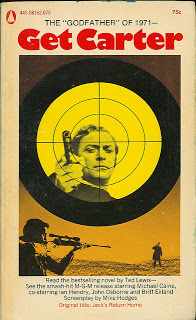
 When you were writing the first Taffin novel were you aware of Ted Lewis’ tough guy novels Get Carterand GBH, which are now considered to be the start of the Brit Grit movement in British hardboiled novels? I knew Get Carterthrough the movie but never read it or GBH. I’m not really aware of movements in novel writing. I grew up with a broad spectrum of writing and hardly read at all when I’m working on a book because it’s too easy to be diverted by a strong style. I read or I write, but don’t combine the two.
When you were writing the first Taffin novel were you aware of Ted Lewis’ tough guy novels Get Carterand GBH, which are now considered to be the start of the Brit Grit movement in British hardboiled novels? I knew Get Carterthrough the movie but never read it or GBH. I’m not really aware of movements in novel writing. I grew up with a broad spectrum of writing and hardly read at all when I’m working on a book because it’s too easy to be diverted by a strong style. I read or I write, but don’t combine the two.
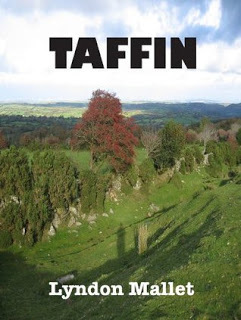 How did you develop the character of Taffin, and did he have any real life counterparts? Early contact with the motor trade put me in touch with the debt collecting business on both sides of the fence. The Taffin idea was sparked off by a friend’s account of ‘being present’ when his employer was having trouble with a supplier. Taffin’s look was based on a burly guy who drove an elderly Cadillac and did a passable Elvis at local gigs. How did you come to write Taffin’s First Law so quickly after Taffinwas published? That’s a simple one. My editor wanted more and I put the concept of a good night’s sleep on hold.
How did you develop the character of Taffin, and did he have any real life counterparts? Early contact with the motor trade put me in touch with the debt collecting business on both sides of the fence. The Taffin idea was sparked off by a friend’s account of ‘being present’ when his employer was having trouble with a supplier. Taffin’s look was based on a burly guy who drove an elderly Cadillac and did a passable Elvis at local gigs. How did you come to write Taffin’s First Law so quickly after Taffinwas published? That’s a simple one. My editor wanted more and I put the concept of a good night’s sleep on hold.
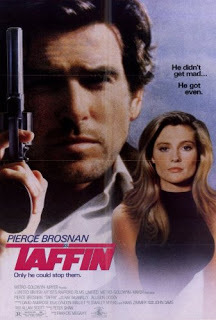 Did your dissatisfaction with the casting of Pierce Brosnan in the film version of Taffin contribute in some way to the hiatus between Ask Taffin Nicely and the soon to be published Taffin On Balance? No. Pierce Brosnan made the character his own as far as the screen was concerned and I was fine with that. I once remarked Pierce Brosnan didn’t fit my original idea of Taffin. Later I was surprised to hear it had become an issue. In fact, if this latest book ever came to the screen, Pierce Brosnan would do a fine job. The producers set the Taffin movie in Ireland for various reasons. The original books are set in rural England. Taffin and most of the characters associated with him (myself included) are English.
Did your dissatisfaction with the casting of Pierce Brosnan in the film version of Taffin contribute in some way to the hiatus between Ask Taffin Nicely and the soon to be published Taffin On Balance? No. Pierce Brosnan made the character his own as far as the screen was concerned and I was fine with that. I once remarked Pierce Brosnan didn’t fit my original idea of Taffin. Later I was surprised to hear it had become an issue. In fact, if this latest book ever came to the screen, Pierce Brosnan would do a fine job. The producers set the Taffin movie in Ireland for various reasons. The original books are set in rural England. Taffin and most of the characters associated with him (myself included) are English.
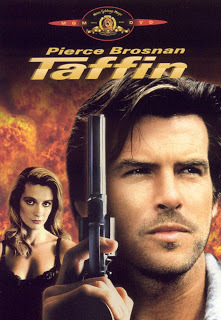 What brought you back to the character of Taffin for a new novel? I had an advertising career that made demands on my time. Life moved on. I had made a switch to scripting for TV and began writing other novels. I thought Ask Taffin Nicely had completed the Taffin trilogy nicely, but somehow the character stayed with me. I guess I always suspected there was more to come. There was a story I wanted to tell and there was only one character to put at the center of it.
What brought you back to the character of Taffin for a new novel? I had an advertising career that made demands on my time. Life moved on. I had made a switch to scripting for TV and began writing other novels. I thought Ask Taffin Nicely had completed the Taffin trilogy nicely, but somehow the character stayed with me. I guess I always suspected there was more to come. There was a story I wanted to tell and there was only one character to put at the center of it.
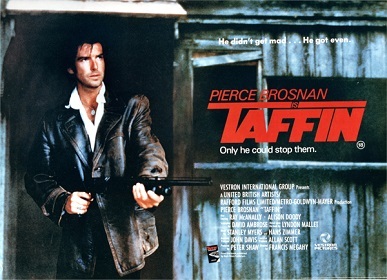 What can we expect from Taffin on Balance? When the new high speed rail route StarTrack threatens a village, Taffin is forced to act in the face of corruption. Set against a background of the classic car trade, in which barn finds are always newsworthy, Taffin on Balance deals with manipulation, at Cabinet level, of a high-speed rail route, and resistance to it at village level.
What can we expect from Taffin on Balance? When the new high speed rail route StarTrack threatens a village, Taffin is forced to act in the face of corruption. Set against a background of the classic car trade, in which barn finds are always newsworthy, Taffin on Balance deals with manipulation, at Cabinet level, of a high-speed rail route, and resistance to it at village level.
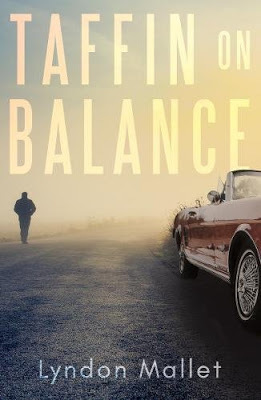 Taffin is now running Muscle Motors with his long-time girlfriend Charlotte, restoring and selling classic American cars. The high-speed rail route StarTrack is threatening the village boundaries and some of the locals approach Taffin for ways of resisting it. He tells them there is nothing he can do, but events draw him in anyway. It seems Taffin’s past is close behind. Someone is trying to put Muscle Motors out of business and it soon becomes clear the threat is well financed, the motive personal and the intention deadly. Taffin is forced to revert to his old skills as he faces corruption that reaches from his home territory into the heart of government. Are there more Taffin tales waiting to be told? Yes.******** Thanks to Lyndon for taking the time to talk Taffin. Do yourself a favor and get acquainted with the first of Taffin’s adventures before Taffin On Balance becomes available in November, 2017...If you don’t, there might be a knock on the door from somebody you don’t want to meet outside the pages of a book...
Taffin is now running Muscle Motors with his long-time girlfriend Charlotte, restoring and selling classic American cars. The high-speed rail route StarTrack is threatening the village boundaries and some of the locals approach Taffin for ways of resisting it. He tells them there is nothing he can do, but events draw him in anyway. It seems Taffin’s past is close behind. Someone is trying to put Muscle Motors out of business and it soon becomes clear the threat is well financed, the motive personal and the intention deadly. Taffin is forced to revert to his old skills as he faces corruption that reaches from his home territory into the heart of government. Are there more Taffin tales waiting to be told? Yes.******** Thanks to Lyndon for taking the time to talk Taffin. Do yourself a favor and get acquainted with the first of Taffin’s adventures before Taffin On Balance becomes available in November, 2017...If you don’t, there might be a knock on the door from somebody you don’t want to meet outside the pages of a book...FOR MORE ABOUT TAFFIN AND LYNDON MALLET CLICK HERE
Published on July 19, 2017 12:20
July 18, 2017
SPECIES: GENUS ÉDITEUR
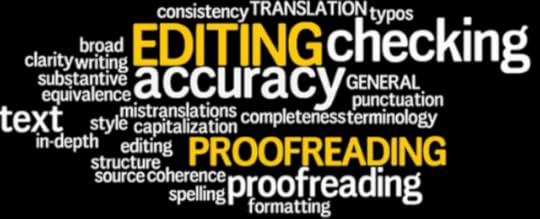 SPECIES: GENUS ÉDITEUR
SPECIES: GENUS ÉDITEURFirst four words about editors—They are not God…
Now a few more words—Working with editors can be confusing and on occasion filled with frustration. I’ve worked with both the good and bad varieties, but I’ve also had the blessing of working with a great editor.
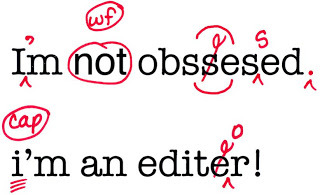 Good editors are the most common of the genus éditeur. These generally kind examples of the species, try to understand what you are attempting to accomplish with your writing. However, they are only willing to work with you if your manuscript is (other than a finalcopy edit) publication ready. They are pleasant enough, but harried and easily distracted by their own problems or workload. They are like parents who raise free-range children, allowing them to run wild, hoping they will eventually turn out okay.
Good editors are the most common of the genus éditeur. These generally kind examples of the species, try to understand what you are attempting to accomplish with your writing. However, they are only willing to work with you if your manuscript is (other than a finalcopy edit) publication ready. They are pleasant enough, but harried and easily distracted by their own problems or workload. They are like parents who raise free-range children, allowing them to run wild, hoping they will eventually turn out okay. Bad editors are like weeds in the flower beds of your prose. They are noxious, prevalent, and can choke the life out of your manuscript. Sometimes, you can feel as if this species of editor is reveling in picking your manuscript apart and insisting on changes because if they don’t change something they don’t feel as if they are doing their job—and sometimes they do it because the can. This breed of editor can leave you feeling as if your manuscript has been bored through with a Roto-Rooter. In general, to give them the benefit of the doubt regarding their level of malevolence, these sour individuals are simply not a good match for your particular manuscript.
 Bad editors may actually be good editors when working in their favorite genre or with important authors—as opposed to working writers. However, when faced with being assigned to edit a manuscript from a genre with which they are not familiar, or simply don’t like, they can become as difficult as a four-year-old having a meltdown in the middle of the cereal aisle. They may view your manuscript as beneath their own literary aspirations. They believe they should be editing Thomas Wolfe or F. Scott Fitzgerald—you know, authors worthy of their attention—instead of wasting their time with you.
Bad editors may actually be good editors when working in their favorite genre or with important authors—as opposed to working writers. However, when faced with being assigned to edit a manuscript from a genre with which they are not familiar, or simply don’t like, they can become as difficult as a four-year-old having a meltdown in the middle of the cereal aisle. They may view your manuscript as beneath their own literary aspirations. They believe they should be editing Thomas Wolfe or F. Scott Fitzgerald—you know, authors worthy of their attention—instead of wasting their time with you. If this happens escape while you still can.
The problem is, beginning writers often confuse the above species. You have to be objective when working with an editor. Are they helping you make the manuscript better, or are they undermining the power of your words?
 Some beginning writers have a hard time overcoming the blinkers of their own writers’ narcissism. They are like mothers who believe their fat, spotty, rude child—otherwise known as their manuscript—is perfect, and woe be to anyone who doesn’t lavish praise, or who dares to change a word. Writer’s like this can’t recognize when the suggestions and changes offered by a good editor are pertinent and needed. Unable to distinguish between the bright plumage of a Good Editor and the black belly feathers of a Bad Editor, they rant and rave and become their own worst enemy. Unless they really are the equivalent of Thomas Wolfe or F. Scott Fitzgerald (not going to happen), they will find the welcome mat missing next time they want to submit a manuscript.
Some beginning writers have a hard time overcoming the blinkers of their own writers’ narcissism. They are like mothers who believe their fat, spotty, rude child—otherwise known as their manuscript—is perfect, and woe be to anyone who doesn’t lavish praise, or who dares to change a word. Writer’s like this can’t recognize when the suggestions and changes offered by a good editor are pertinent and needed. Unable to distinguish between the bright plumage of a Good Editor and the black belly feathers of a Bad Editor, they rant and rave and become their own worst enemy. Unless they really are the equivalent of Thomas Wolfe or F. Scott Fitzgerald (not going to happen), they will find the welcome mat missing next time they want to submit a manuscript.There is another breed of beginning writer at the other end of the spectrum. They can’t imagine ever disagreeing with an editor. They often end up butchering their fragile bonsai tree of a manuscript trying to please an editor, who may or may not have the best interest of the manuscript at heart.
 Great editors are rare and magical beasts. They are actually able to see what works and doesn’t work in your novel. They make considered and constructive suggestions, help you find solutions to manuscript problems, encourage you through the hard process of making changes, and become a true partner in the publishing process. If you are lucky enough to come across a Great Editor in the wild, protect them with your life. They will make you a better writer and a better person. They might not turn your manuscript into a bestseller, but they will ensure it will sell better than it would without their input.
Great editors are rare and magical beasts. They are actually able to see what works and doesn’t work in your novel. They make considered and constructive suggestions, help you find solutions to manuscript problems, encourage you through the hard process of making changes, and become a true partner in the publishing process. If you are lucky enough to come across a Great Editor in the wild, protect them with your life. They will make you a better writer and a better person. They might not turn your manuscript into a bestseller, but they will ensure it will sell better than it would without their input.But let’s get back to the point of this diatribe—Editors are not God.
As a writer, I’ve long believed the myth most editors are trolls living under their desks, snatching at any winsome manuscript trying to cross their transom. I am loath to give up this unreasonable impression, even though I now find myself turning into a troll as my own role as an editor expands.
Remember, an editor’s comments on your manuscript are opinions. We may be wrong (but probably not). Comments on your manuscript are not judgements of you as a person or even as a writer. I wrote a lot of bad crap before the scent of my pros began to become more acceptably aromatic.
Speaking for myself, I am completely capable of getting things wrong. If you send me a historical romance to edit, my tendency would be to strip down your flowing prose, excise all of the yucky moony-eyed stuff, editing you by the standards of another genre with which I am more familiar.
 Hopefully, I have evolved as an editor to the point where I don’t do this. I have grown to understand the tropes of many other genres beyond my own. I could be a good editor for a historical romance or sweet romance or even an erotic romance. However, I will never be a great editor in those genres because I have nothing to add to make a manuscript better other than the generic literary conventions. I could make such a manuscript’s construction better, but I most likely couldn’t help it sing.
Hopefully, I have evolved as an editor to the point where I don’t do this. I have grown to understand the tropes of many other genres beyond my own. I could be a good editor for a historical romance or sweet romance or even an erotic romance. However, I will never be a great editor in those genres because I have nothing to add to make a manuscript better other than the generic literary conventions. I could make such a manuscript’s construction better, but I most likely couldn’t help it sing.What does all of this mean when you submit a manuscript or work with an editor? First, when your chosen editor makes comments and suggestions, don’t take them personally. Try to be objective about them. Do they make sense? Do they make your manuscript stronger? Don’t be obnoxious, but neither be afraid to disagree. I personally am open to a back and forth literary relationship. I may not get what you are trying to do until you explain it to me. Once I understand, I can tailor my advice and encouragement.
I am certainly not the final word on the worth of a manuscript or even the changes I think should be made. No editor is. This is about your writing, not a troll’s editing. Still, as a writer, you need to be open and prepared to learn from an editor’s experience, while not allowing your vision to be derailed.
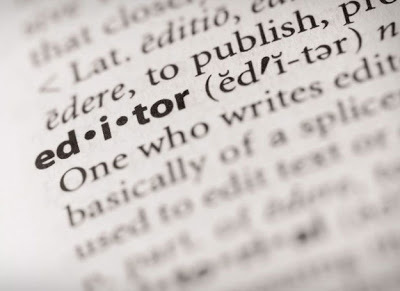 ONE FINAL NOTE:
ONE FINAL NOTE: If you are working with and editor or a mentor in a writers’ group or writers’ conference, shopping around for other input can be a dangerous path. After offering advice, no editor or mentor wants to be told be told in a whiney voice, “But you’re telling me the complete opposite of what so-and-so said.” This type of shopping for advice from different individuals will only lead you to a cornucopia of conflicting advice, causing utter confusion and frustration for a beginning writer.
An editor or a mentor offers advice and opinions. Throwing up your arms and telling an them another writing guru gave the total opposite advice, is the quickest way to make your current editor or mentor abandon you in midstream. If an editor or mentor’s advice is conflicting with what you’ve been told, keep your own counsel, consider the advice, and make a decision about which editor or mentor your instincts tell you is right. Then—most importantly—stop shopping around and stick with the individual who serves you best.
Published on July 18, 2017 17:44
THE FISTS OF ROBERT E. HOWARD
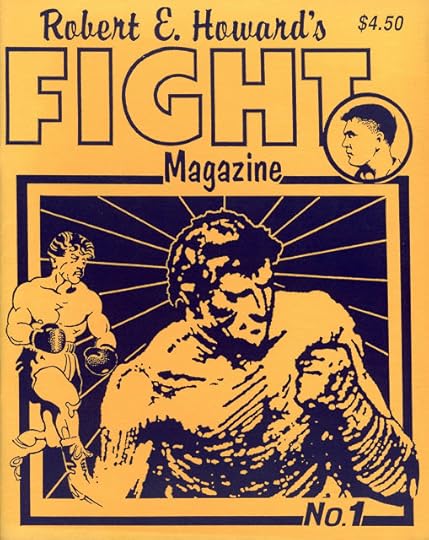 THE FISTS OF ROBERT E. HOWARD
THE FISTS OF ROBERT E. HOWARDThe minute I stepped ashore from the Sea Girl, merchantman, I had a hunch that there would be trouble. This hunch was caused by seeing some of the crew of the Dauntless. The men on the Dauntless have disliked the Sea Girl’s crew ever since our skipper took their captain to a cleaning on the wharfs of Zanzibar – them being narrow-minded that way. They claimed that the old man had a knuckle-duster on his right, which is ridiculous and a dirty lie. He had it on his left. ~ Robert E. Howard, The Pit of the Serpent
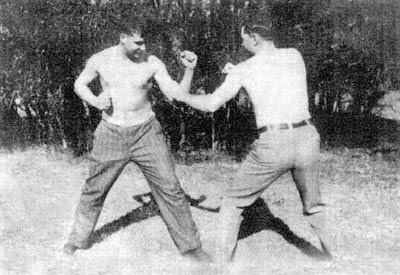 Although best known as the creator of Conan the Barbarian, Solomon Kane, and other sword and sorcery characters, Robert E. Howard (REH) had a lifelong interest in boxing, attending fights and avidly following the careers of his favorite fighters. Even though as a child he was bookish and intellectual, in his teen years he took up bodybuilding and eventually entered the ring as an amateur boxer.
Although best known as the creator of Conan the Barbarian, Solomon Kane, and other sword and sorcery characters, Robert E. Howard (REH) had a lifelong interest in boxing, attending fights and avidly following the careers of his favorite fighters. Even though as a child he was bookish and intellectual, in his teen years he took up bodybuilding and eventually entered the ring as an amateur boxer. 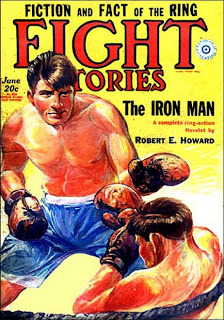 During the height of the pulp magazine era from the late ‘20s through the ‘30s, REH used this background to make a good living banging out boxing tales for the likes of Fight Stories Magazine, Action Stories, Sport Story, Jack Dempsey’s Fight Magazine, and others. REH actually claimed his fictional fight tales—especially The Iron Man, and the adventures of Sailor Steve Costigan—to be among the best of his works. Primarily humorous in nature, Howard’s most popular and in demand boxing stories featured Sailor Steve Costigan. These tales were both creatively and financially critical to Howard’s development as a writer.
During the height of the pulp magazine era from the late ‘20s through the ‘30s, REH used this background to make a good living banging out boxing tales for the likes of Fight Stories Magazine, Action Stories, Sport Story, Jack Dempsey’s Fight Magazine, and others. REH actually claimed his fictional fight tales—especially The Iron Man, and the adventures of Sailor Steve Costigan—to be among the best of his works. Primarily humorous in nature, Howard’s most popular and in demand boxing stories featured Sailor Steve Costigan. These tales were both creatively and financially critical to Howard’s development as a writer.Costigan was a lovable, hard-fisted, and innocent semipro pugilist who regularly squared-off against dastardly villains in exotic ports of call. Tales featuring Costigan were at times laugh out loud funny and brilliant examples of what, in writing circles, is referred to as an unreliable narrator. Written in first person, the voiceof Sailor Steve Costigan is full of malapropisms and creative, near-swear invective.
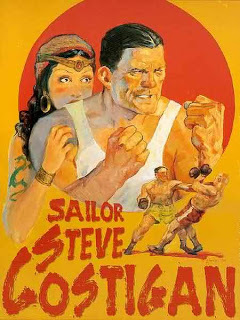 As the undisputed champion of the merchant marine Sea Girl, Costigan has a heart of gold, fists of steel, and a head full of rocks, all of which get him—and his bulldog Mike—tossed into constant trouble. Costigan is lovable for two reasons. First, he is just not smart enough to do anything other than punch his way clear of trouble. And second, when he starts punching, every reader feels the joy of the underdog overcoming the odds with the solid landing of every blow.
As the undisputed champion of the merchant marine Sea Girl, Costigan has a heart of gold, fists of steel, and a head full of rocks, all of which get him—and his bulldog Mike—tossed into constant trouble. Costigan is lovable for two reasons. First, he is just not smart enough to do anything other than punch his way clear of trouble. And second, when he starts punching, every reader feels the joy of the underdog overcoming the odds with the solid landing of every blow. No matter how ridiculous the situation he places Costigan in, REH never ridicules the character, always putting Costigan on the side of the angels. Readers know they should always bet on Costigan coming through victorious in a fight, and they would be more than willing to share a beer with him afterward. Not too many readers would want to share suds with the brutal Conan or the dour Solomon Kane. Costigan is accessible, a larger than life everyman.
Not all of REH’s boxing stories are funny. Aside from essays exploring what attributes REH believed made a great boxer, his other boxing tales were alive with the sound and the fury of the real world of the square circle. In particular, his novelette Iron Man, is a revered saga for those followers not just of REH, but of boxing enthusiasts in general.
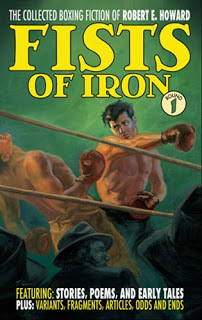 Over the years, REH’s boxing fiction has been reprinted in various incomplete collections. However, between 2013 and 2015, the ultimate collection of REH’s boxing fiction was amassed by the Robert E. Howard Foundation Press and published in the four volume Fists of Iron collection. This has finally given these overlooked works their rightful place in the Howard pantheon.
Over the years, REH’s boxing fiction has been reprinted in various incomplete collections. However, between 2013 and 2015, the ultimate collection of REH’s boxing fiction was amassed by the Robert E. Howard Foundation Press and published in the four volume Fists of Iron collection. This has finally given these overlooked works their rightful place in the Howard pantheon. These beautifully bound and numbered, hardcover editions sport stunning, pulp inspired wrap around covers and contain every story, partial story, and scrap of idea Howard produced in relation to the sweet science of boxing. Editors, Mark Finn, Patrice Louinet, and Christopher Gruber each contributed insightful and extensive introductions to the volumes, in what was clearly a labor of love and appreciation for REH’s work.
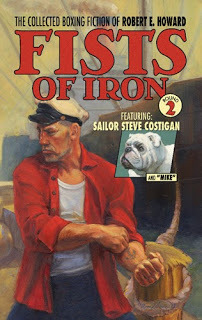 The complete compendium of Fist of Iron has not only become a highly sought after collector’s item, but has preserved the two-fisted tales that helped a generation of readers to fight through the Great Depression and the tough years to follow. Even today, REH’s boxing fiction reads with immediacy and storytelling power. If you’ve never met, or never heard of REH’s boxing characters Sailor Steve Costigan, Kid Allison, Mike O’Brien, or Dennis Dorgan, now is the time to lace up your gloves, put up your dukes, and climb into the ring.
The complete compendium of Fist of Iron has not only become a highly sought after collector’s item, but has preserved the two-fisted tales that helped a generation of readers to fight through the Great Depression and the tough years to follow. Even today, REH’s boxing fiction reads with immediacy and storytelling power. If you’ve never met, or never heard of REH’s boxing characters Sailor Steve Costigan, Kid Allison, Mike O’Brien, or Dennis Dorgan, now is the time to lace up your gloves, put up your dukes, and climb into the ring.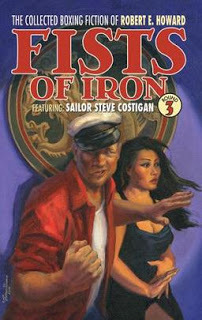
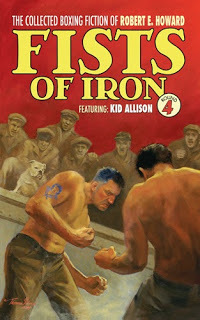 ********NOTE: I would be remiss at this point if I did not mention a collection of boxing tales inspired by REH’s Sailor Steve Costigan Tales. Mark Finn, one of the editors behind the Fists of Iron collection created a series of short stories featuring a two-fisted character as a homage to REH’s Sailor Steve Costigan. As the editor of the Fight Card series of novels (now 50 strong), I had the delight of editing and publishing these stories in the collection,
Fight Card: The Adventures of Sailor Tom Sharkey
.
********NOTE: I would be remiss at this point if I did not mention a collection of boxing tales inspired by REH’s Sailor Steve Costigan Tales. Mark Finn, one of the editors behind the Fists of Iron collection created a series of short stories featuring a two-fisted character as a homage to REH’s Sailor Steve Costigan. As the editor of the Fight Card series of novels (now 50 strong), I had the delight of editing and publishing these stories in the collection,
Fight Card: The Adventures of Sailor Tom Sharkey
.
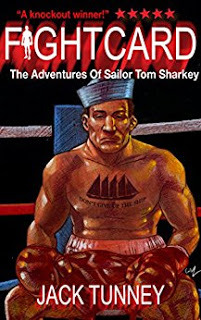 Channeling the best of REH’s boxing tales, The Adventures of Sailor Tom Sharkey are a terrific blend of weird, historical, and humorous boxing stories to be read and enjoyed. As for Sailor Tom Sharkey himself, he is one of the greatest heavyweight boxers to enter the legendary squared circle during the Golden Age of Boxing. Standing a mere 5’ 8”, Sailor Tom Sharkey is one of boxing’s most feared opponents…Gentleman Jim Corbett, Bob Fitzsimmons, Kid McCoy, and Jim Jeffries all agreed he was their fiercest opponent and gave them their toughest fights. A colorful boxer both in the ring and out, he retired in 1904 after several legendary and controversial failed attempts to win the championship belt. That’s the story you know, but it’s not the end of Sharkey’s story—not by a long shot. The Adventures of Sailor Tom Sharkey collects the rowdy, bawdy, burlesque, tall Texas tales of Sailor Tom Sharkey’s shenanigans after he hung up his professional gloves. There’s Sharkey’s brush with Hollywood’s “It” Girl, Clara Bow. There are chills as Sharkey and Kid McCoy face down a maniacal bandit. And the heat gets turned up when Sharkey rides the rails with Jim Jeffries and the Vaudeville Carnival into a clash with mad scientists and mummified menaces. And for the softer side of Sharkey, you can watch as he plays Santa Claus to a bunch of Tammany Hall orphans and ends up with a tiger by the tail—literally. These are the untold tales of the wildest tale-teller of boxing’s golden age…
Channeling the best of REH’s boxing tales, The Adventures of Sailor Tom Sharkey are a terrific blend of weird, historical, and humorous boxing stories to be read and enjoyed. As for Sailor Tom Sharkey himself, he is one of the greatest heavyweight boxers to enter the legendary squared circle during the Golden Age of Boxing. Standing a mere 5’ 8”, Sailor Tom Sharkey is one of boxing’s most feared opponents…Gentleman Jim Corbett, Bob Fitzsimmons, Kid McCoy, and Jim Jeffries all agreed he was their fiercest opponent and gave them their toughest fights. A colorful boxer both in the ring and out, he retired in 1904 after several legendary and controversial failed attempts to win the championship belt. That’s the story you know, but it’s not the end of Sharkey’s story—not by a long shot. The Adventures of Sailor Tom Sharkey collects the rowdy, bawdy, burlesque, tall Texas tales of Sailor Tom Sharkey’s shenanigans after he hung up his professional gloves. There’s Sharkey’s brush with Hollywood’s “It” Girl, Clara Bow. There are chills as Sharkey and Kid McCoy face down a maniacal bandit. And the heat gets turned up when Sharkey rides the rails with Jim Jeffries and the Vaudeville Carnival into a clash with mad scientists and mummified menaces. And for the softer side of Sharkey, you can watch as he plays Santa Claus to a bunch of Tammany Hall orphans and ends up with a tiger by the tail—literally. These are the untold tales of the wildest tale-teller of boxing’s golden age…
Published on July 18, 2017 16:40
AVOIDING THE CURSE OF BACKSTORY INFO DUMPS
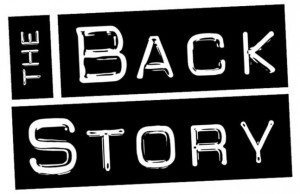 AVOIDING THE CURSE OF BACKSTORY INFO DUMPS
AVOIDING THE CURSE OF BACKSTORY INFO DUMPSIn fiction, backstory is what has happened prior to the current narrative frame of the story—the history created for a fictional character or situation. Properly used, it enriches a story by revealing cause and effect. Improperly used, it is a cumbersome boring information dump of exposition.
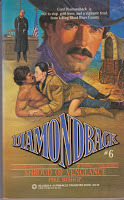 My first novel, Shroud of Vengeance, was part of an ongoing western series featuring a character named Diamondback. The books in the series were written by several different authors using a publishing house owned pseudonym. The editor gave me the bible for the series, which provided the limited information needed as part of the character’s backstory: Diamondback got his nickname after being the victim of a horrible whipping; he is wanted for a murder he didn’t commit; he wanders the west acting as a travelling judge settling disputes between outlaws and he is popular with the ladies.
My first novel, Shroud of Vengeance, was part of an ongoing western series featuring a character named Diamondback. The books in the series were written by several different authors using a publishing house owned pseudonym. The editor gave me the bible for the series, which provided the limited information needed as part of the character’s backstory: Diamondback got his nickname after being the victim of a horrible whipping; he is wanted for a murder he didn’t commit; he wanders the west acting as a travelling judge settling disputes between outlaws and he is popular with the ladies.The goal was to include this background information in an unobtrusive manner enabling the books to be read in any order without intrusive information dumps or large chunks of narrative explanation. Drop the nickname on the first page, show his scars when he takes off his shirt, and tie the plot into a dispute between dangerous outlaws for Diamondback to settle. With a series of this type, the main character remains static. There are no consequences or character arcs to carry over from one book to the next—as if each was a standalone novel.
Until the last decade most television series were also examples of this type of storytelling. This was perfect for reruns, as series could be shown in any order. Think about I Love Lucy. It doesn’t matter which episode a viewer watches, the set-up is immediately clear—wacky redhead doing wacky things. There is no need to know what has happened in prior episodes. There are no ongoing storylines to confuse the narrative if episodes are shown out of order. Many, many mystery and cop shows operated, and still operate, on the same principle. However, times have changed. Now, books and many of the most popular television series thrive on ongoing storylines continuing from episode to episode, or book to book, to maintain viewer/reader loyalty.
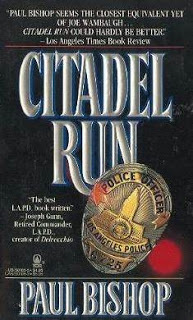 When my literary career moved on from writing under a house name pseudonym (which in the case of Diamondback just happened to be Pike Bishop) to Citadel Run, my first novel under my own name, I ran into this problem. What I had envisioned as a standalone novel, suddenly became the first in a series when the publisher asked for another book with the same characters. Staring at the blank page before first word of Sand Against the Tide, I was faced with the problem of how to integrate the complicated backstory and relationships of the characters established in the first book into the narrative of the sequel.
When my literary career moved on from writing under a house name pseudonym (which in the case of Diamondback just happened to be Pike Bishop) to Citadel Run, my first novel under my own name, I ran into this problem. What I had envisioned as a standalone novel, suddenly became the first in a series when the publisher asked for another book with the same characters. Staring at the blank page before first word of Sand Against the Tide, I was faced with the problem of how to integrate the complicated backstory and relationships of the characters established in the first book into the narrative of the sequel.My issues with the situation included overcoming the fact I had wrapped the first book up with the main character retiring from the police department, and his female partner promoting to detective. I would never have done this if I had realized I was going to be writing more books with the same characters. As it was, I had to quickly figure out a fictional situation in which these two main characters could continue to interact together on the same case.
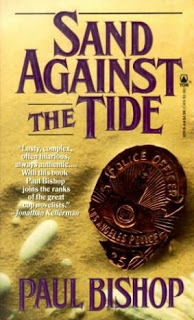 After Sand Against the Tide was published, I went on to write another standalone novel, Chapel of the Ravens. Not having learned my lesson the first time around, I again ended the novel in a way precluding an easy transition to a second book with the same character. Consequently, there was never a second book. Publishers love series characters as a way to build reader loyalty, and I was shooting myself in the foot.
After Sand Against the Tide was published, I went on to write another standalone novel, Chapel of the Ravens. Not having learned my lesson the first time around, I again ended the novel in a way precluding an easy transition to a second book with the same character. Consequently, there was never a second book. Publishers love series characters as a way to build reader loyalty, and I was shooting myself in the foot.When I sat down to write my next novel, Kill Me Again, I decided upfront I would also design the book to be the first in a series. As a result, I outlined a four book story arc for the main character, LAPD detective Fey Croaker. I also took into consideration story arcs for the secondary characters comprising her crack homicide squad.
 One of my concerns was how much background from the first book in the series needed to be included in the second. And how about the third and fourth books? Did I need the same amount of backstory? More? Less? Or did I need any?
One of my concerns was how much background from the first book in the series needed to be included in the second. And how about the third and fourth books? Did I need the same amount of backstory? More? Less? Or did I need any?Currently, most television show writing staffs plan out a full season story arc before any individual episodes are written. When the individual episodes are created, there is already a larger established macro arccontaining what information needs to be included in the micro arc of each individual episode to keep viewers watching.
There is usually a quick story recap provided, through dialogue, at the beginning of each individual script act. This is done to bring a viewer up to speed if they have just turned on their set or are channel surfing from other shows. Television also uses previously on… lead-ins before the new episode starts to remind regular viewers of story points, or bring new viewers into the fold.
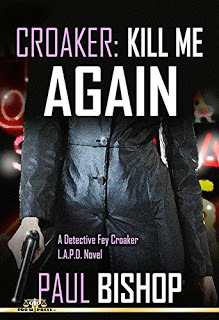 The previously on… technique is virtually impossible to use in the novel form. Prologues have become unfashionable in our modern world of instant gratification. Contemporary readers want to jump right into a story without wading through a prologue providing either tedious backstory or unnecessary teaser information.
The previously on… technique is virtually impossible to use in the novel form. Prologues have become unfashionable in our modern world of instant gratification. Contemporary readers want to jump right into a story without wading through a prologue providing either tedious backstory or unnecessary teaser information.So, what to do?
In episodic television, you never hear long expositional explanations of character history or incidents from previous episodes. Instead, the action on the screen is so crisp and clear, viewers become invested in the show from the first scene.
The same thing needs to happen on the page.
To accomplish this, you need to emulate what occurs in the television world, where staff writers for a show create a macro story arc for the season before creating the micro story arcs for each individual episode.
This way, each individual episode of a show contains all of the beats of the micro arc for the episodes specific storyline, as well as one, two, or three beats needed to progress the storyline of the macro arc.
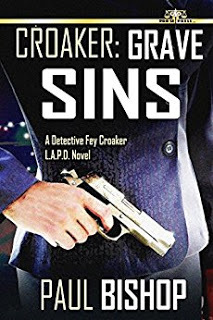 To imitate this, you need to create a macro story arc for the first three to four books you plan in a series. Then, as you write the micro arc of the plot for each individual novel, you also included several elements from your macro arcwhich continues from book to book.
To imitate this, you need to create a macro story arc for the first three to four books you plan in a series. Then, as you write the micro arc of the plot for each individual novel, you also included several elements from your macro arcwhich continues from book to book.The macro arc for my Fey Croaker novels involved Fey’s personal life deteriorating and her character becoming more and more isolated until in book four, Chalk Whispers, events force her to deal with the demons of the abuses from her past.
In the first book, Kill Me Again, I established Fey’s background, laying out the beginnings of the macro arc, as she moved through the books specific plot of a current murder victim whose identity shows she was murdered ten years earlier—the micro arc of this specific book.
In Grave Sins, the micro arcdeals with a series of male murders possibly committed by an NBA rookie phenom. To keep the macro arc progressing, I included several elements to turn up the heat on Fey—her professional ethics are called into question; her low-life brother makes unreasonable demands and ends up as the killers bait. Without giving all the twists away, Fey ends the storyline completely isolated from family and increasingly distanced from her own team.
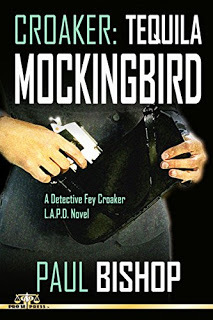 The micro arc of Tequila Mockingbird takes Fey and her crew into the world of deep undercover cops—referred to as mockingbirds—when one is murdered in front of station. As Fey unravels the plot, she is aided by a character with whom she can’t help falling in love despite the fact she knows he’s dying (more crushing isolation). There is a strong, action-filled ending to the book, but Fey finishes shattered, emotionally raw, and completely vulnerable—fulfilling the needs of the macro arc.
The micro arc of Tequila Mockingbird takes Fey and her crew into the world of deep undercover cops—referred to as mockingbirds—when one is murdered in front of station. As Fey unravels the plot, she is aided by a character with whom she can’t help falling in love despite the fact she knows he’s dying (more crushing isolation). There is a strong, action-filled ending to the book, but Fey finishes shattered, emotionally raw, and completely vulnerable—fulfilling the needs of the macro arc.The four book macro arc culminates in Chalk Whispers, where it is completely tied into the micro arc of a plot involving a cold case investigated by Fey’s deceased, abusive, cop father. As the past comes back, it puts Fey’s life in danger, forcing her to confront all her own bad behaviors, co-dependencies, and mistakes, which have led her to this point in her life. She eventually finds personal vindication through the final resolution of the macro arc.
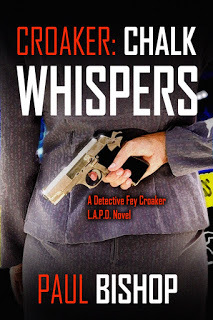 Within each of those novels, I also worked in macro arcs for each of the partnership duos comprising Fey’s homicide team—giving them each a specific, ongoing, subplot involving their own personal journey. The characters grow and change as they overcome their personal challenges while playing their parts in unraveling the plot—the micro arc—of each book.
Within each of those novels, I also worked in macro arcs for each of the partnership duos comprising Fey’s homicide team—giving them each a specific, ongoing, subplot involving their own personal journey. The characters grow and change as they overcome their personal challenges while playing their parts in unraveling the plot—the micro arc—of each book.By using a macro arc, which slowly spools out, each novel in a series has its own internal structure, allowing returning and new readers alike to keep moving forward without feeling they have either missed something or be bored by the same info dumps of backstory again and again.
To recap: A macro arc contains those things your characters need to be slowly accomplishing as the series progresses. The individual plots to your novels comprise the micro arc story beats your characters need to rapidly accomplish in resolving the current story line.
If you follow a three or four book macro arc for your series, you won’t need any exposition about the past. If your writing is crisp enough, the established structure and character interactions will quickly become clear as they fulfill the micro arc in the current storyline. This is the dynamic that keeps the pages turning.
***When Citadel Run, Sand Against the Tide, and Chapel of the Ravens were converted to e-books, they also underwent title changes respectively, Hot Pursuit , Deep Water , and Penalty Shot ...
Published on July 18, 2017 13:58
July 13, 2017
BABY DRIVER
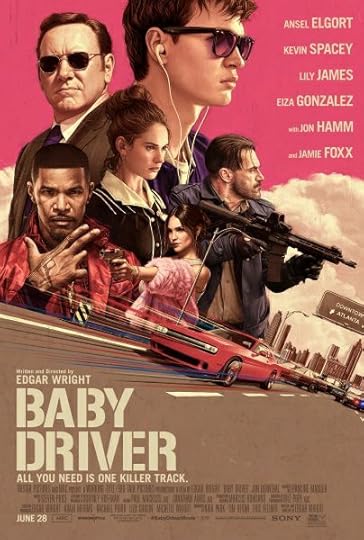 BABY DRIVER It would be easy to dismiss Baby Driver as all flash and no substance. However, while there is a lot of flash on the screen there is also a surprising amount of heart. The movie is uniquely choreographed with much of the action cleverly timed to the beat of the soundtrack, right down to the cadence of the dialogue.
BABY DRIVER It would be easy to dismiss Baby Driver as all flash and no substance. However, while there is a lot of flash on the screen there is also a surprising amount of heart. The movie is uniquely choreographed with much of the action cleverly timed to the beat of the soundtrack, right down to the cadence of the dialogue. Ansel Elgort is perfectly cast as the baby-faced getaway driver of the title, and the car chases—especially the opening sequence—put the Fast and Furious franchise to shame. There is a believable story backing the outrageous action, and you buy in to the teenage love story thanks to the presence of Lily James, who has a strong chemistry with Elgort and a dynamite smile. Kevin Spacey, Jon Hamm, and Jamie Foxx perform their parts in a workman-like fashion (although Hamm does ride above journeyman status by the final scenes), never detracting from the action.
Baby Driver is not going to win any Oscars, but for a two hour testosterone fueled rampage, I found it thoroughly entertaining...
Published on July 13, 2017 08:15
July 8, 2017
SPIDER-MAN—A REAL HOMECOMING
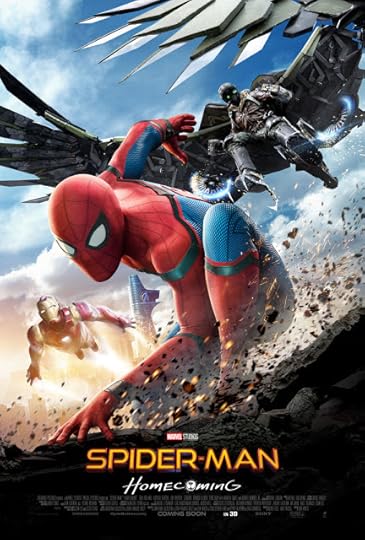 SPIDER-MAN—A REAL HOMECOMING
SPIDER-MAN—A REAL HOMECOMINGThe latest (and most probably successful) attempt to reboot the Spider-Man franchise is a homecomingin much more than name only. It’s finally a return to an understanding of what has made Spider-Man such a favorite among his legions of comic book fans.
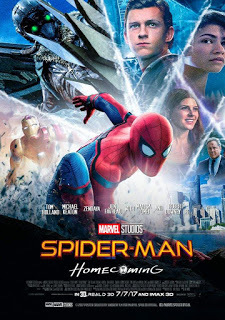 In many ways Spider-Man Homecoming is another typical over-the-top, CGI heavy, summer tent-pole blockbuster, but there are enough good things to help it rise above the mire. Don't get me wrong, Spider-Man Homecomingdoes not come close to the delights of Wonder Woman, but then no other superhero movie of recent vintage does either—with the possible exception of Deadpool, which is a law into itself and can't really be compared to anything else in the genre.
In many ways Spider-Man Homecoming is another typical over-the-top, CGI heavy, summer tent-pole blockbuster, but there are enough good things to help it rise above the mire. Don't get me wrong, Spider-Man Homecomingdoes not come close to the delights of Wonder Woman, but then no other superhero movie of recent vintage does either—with the possible exception of Deadpool, which is a law into itself and can't really be compared to anything else in the genre.I’ll get to the good later—and there is a lot of good—but I’ll start by pointing out the bad, which, unfortunately, is fairly easy. Before Spider-Man Homecoming swings from its first web, it has to conquer a number of evil gremlins inherent to the production.
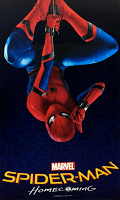
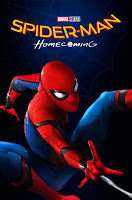 There are major plot holes in the script, including where the rest of the Avengers are when Spider-Man is trying singlehandedly trying to stop the Vulture from destroying Queens. We're told this destruction doesn't rise to the level of the Avengers’ attention. Apparently, saving New York is beneath them as they are too busy saving the world and the universe...Huh? What? Really? Tony Stark/Ironman isn’t even saving the world since he has a bunch of parties to attend.
There are major plot holes in the script, including where the rest of the Avengers are when Spider-Man is trying singlehandedly trying to stop the Vulture from destroying Queens. We're told this destruction doesn't rise to the level of the Avengers’ attention. Apparently, saving New York is beneath them as they are too busy saving the world and the universe...Huh? What? Really? Tony Stark/Ironman isn’t even saving the world since he has a bunch of parties to attend. Plus, are the Avengers so arrogant or so stupid as to put all their eggs in one basket on moving day and allow their big-ass airplane, filled with all their Avenger goodies, to fly away with no crew or pilots on board (let alone any Avengers along for security)? And here you were worried about self-driving cars.
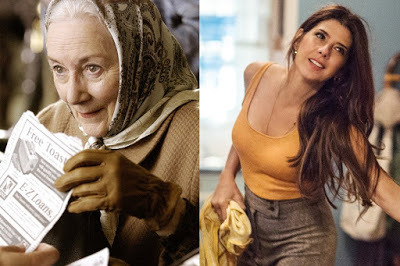
Rosemary Harris as Aunt May in Spider-Man 2
Marisa Tomei as the ‘Hot Italian’ Aunt May in Spider-Man Homecoming
Next let’s talk about Aunt May (Marisa Tomei in a thankless role)...What studio executive thought making her a hot Italian woman who makes Mrs. Robinson appear shy by comparison. I got a whole creepy vibe from her relationship with Peter Parker/Spidey, which was distracting every time she was on screen.
 Spider-Man Homecomingalso sufferers from comic comparison—what looks cool on the pages of a comic book looks completely ridiculous on the big screen. The whole Staten Island Ferry being cut in half thing (no spoiler as it’s in the trailer), but being held together by about two miles of Spidey’s webs is more than silly. My suspension of disbelief couldn’t be held together by Spidey’s webs, let alone the Staten Island Ferry.
Spider-Man Homecomingalso sufferers from comic comparison—what looks cool on the pages of a comic book looks completely ridiculous on the big screen. The whole Staten Island Ferry being cut in half thing (no spoiler as it’s in the trailer), but being held together by about two miles of Spidey’s webs is more than silly. My suspension of disbelief couldn’t be held together by Spidey’s webs, let alone the Staten Island Ferry.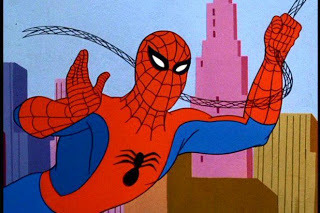 Okay, I get it, it’s a cartoon—or is it? We’re supposed to take this stuff seriously, but I’m sitting there marveling at how Spidey’s web shooters are like six-guns in a Western that never run out of bullets. Somehow, he can store two miles of webbing in his skintight suit, but the second a plot point needs to ratchet up the tension, the webbing runs out at the exact moment it’s needed most.
Okay, I get it, it’s a cartoon—or is it? We’re supposed to take this stuff seriously, but I’m sitting there marveling at how Spidey’s web shooters are like six-guns in a Western that never run out of bullets. Somehow, he can store two miles of webbing in his skintight suit, but the second a plot point needs to ratchet up the tension, the webbing runs out at the exact moment it’s needed most.I could go on, but there isn’t much point. All of these complaints are generic as they can be applied to every superhero movie (except for Deadpool, which in it’s strange self-referencing way is a parody of all superhero movies), and the good points of Spider-Man Homecoming far outweigh the bad.
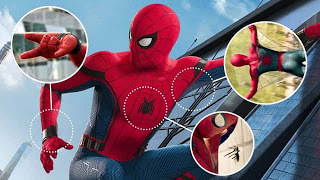 More than any other Spider-Man movie, Spider-Man Homecoming finally gets it right—or at least more right than what has gone before. Anchoring the story in Queens was a great choice.
More than any other Spider-Man movie, Spider-Man Homecoming finally gets it right—or at least more right than what has gone before. Anchoring the story in Queens was a great choice. 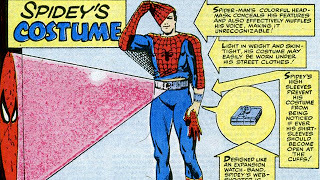 Doing away completely with the origin story, except for a I was bitten by a spider throwaway line, was a relief after having been done to death in prior films. And a fine balance between humor and pathos was laudably achieved. There is also major unexpectedplot twist, which I am both ashamed and happy to admit I didn’t see coming (kudos writers, kudos). And—oh, yeah—his costume is cool...
Doing away completely with the origin story, except for a I was bitten by a spider throwaway line, was a relief after having been done to death in prior films. And a fine balance between humor and pathos was laudably achieved. There is also major unexpectedplot twist, which I am both ashamed and happy to admit I didn’t see coming (kudos writers, kudos). And—oh, yeah—his costume is cool...While the above things are good, there are two other excellent factors—Tom Holland and Michael Keaton. Both actors bring new dimensions to the standard superhero supervillain roles.
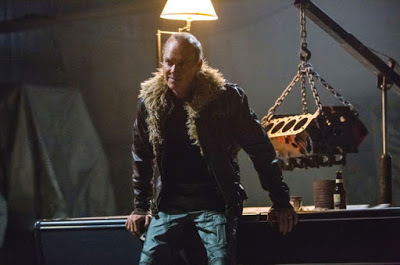 Keaton resists the all too tempting urge to chew scenery. Instead, by subtly playing up the misguided humanity of his villain, he makes the Vulture into an understandable, if not quite sympathetic anti-hero (there is some kinship here with his Oscar winning role in Birdman). You could find yourself rooting for him under other circumstances—and you do get the chance to cheer from him if you are willing to sit through the credits.
Keaton resists the all too tempting urge to chew scenery. Instead, by subtly playing up the misguided humanity of his villain, he makes the Vulture into an understandable, if not quite sympathetic anti-hero (there is some kinship here with his Oscar winning role in Birdman). You could find yourself rooting for him under other circumstances—and you do get the chance to cheer from him if you are willing to sit through the credits. However, it is gymnast ballet dancer Tom Holland to whom the success of the film belongs. You totally buy off on him being the fifteen year old Peter Parker, an awkward whiz kid whose world has been rocked by a radioactive spider bite. He has no idea what to do with all these cool superpowers and, more often than not, makes a hash out of his efforts. This is both hilarious an endearing—exactly like the Peter Parker of the original comic run.
However, it is gymnast ballet dancer Tom Holland to whom the success of the film belongs. You totally buy off on him being the fifteen year old Peter Parker, an awkward whiz kid whose world has been rocked by a radioactive spider bite. He has no idea what to do with all these cool superpowers and, more often than not, makes a hash out of his efforts. This is both hilarious an endearing—exactly like the Peter Parker of the original comic run.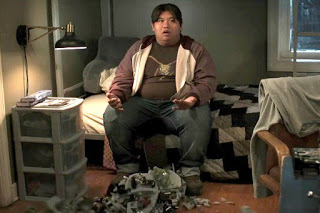 Holland makes Peter Parker’s never ending high school traumas squirm worthy, making you long for his tormentor’s comeuppance (again, exactly like the trials of the comic book Peter Parker). But these life difficulties are offset by Peter’s relationship with his even more awkward (but trying desperately to be cool) pal, Ned Leeds. Jacob Batalon, makes this role a triumph for second banana, man in the chair, actors everywhere.
Holland makes Peter Parker’s never ending high school traumas squirm worthy, making you long for his tormentor’s comeuppance (again, exactly like the trials of the comic book Peter Parker). But these life difficulties are offset by Peter’s relationship with his even more awkward (but trying desperately to be cool) pal, Ned Leeds. Jacob Batalon, makes this role a triumph for second banana, man in the chair, actors everywhere.  Zendaya also deserves an honorable mention for playing against type and giving us an intriguing glimpse of the is she or isn’t she Mary Jane of the future.
Zendaya also deserves an honorable mention for playing against type and giving us an intriguing glimpse of the is she or isn’t she Mary Jane of the future. The first two acts of Spider-Man Homecoming, which are as strong as Spidey’s webbing, are human, humorous, and true enough to the source material to make the CGI destruction, laws of physics defying, antics of the third act’s traditional superhero movie climax acceptable.
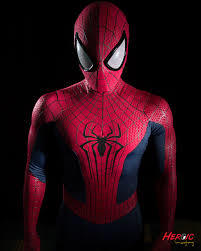 Spider-Man Homecominghas restored my interest in Spider-Man—my favorite comic book hero from my teen years—which had waned after the past attempts to get the franchise off the ground. On the strength of Spider-Man Homecoming, due in large part to Marvel Studios finally gaining control of the franchise back from Sony, I’ll certainly be in the theater eagerly anticipating the opening scenes of the next installment.
Spider-Man Homecominghas restored my interest in Spider-Man—my favorite comic book hero from my teen years—which had waned after the past attempts to get the franchise off the ground. On the strength of Spider-Man Homecoming, due in large part to Marvel Studios finally gaining control of the franchise back from Sony, I’ll certainly be in the theater eagerly anticipating the opening scenes of the next installment. 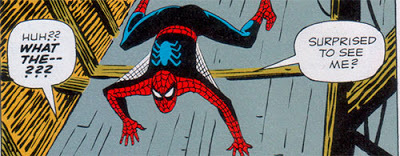
Published on July 08, 2017 12:56
July 4, 2017
BRIT SPY—GAVIN LYALL
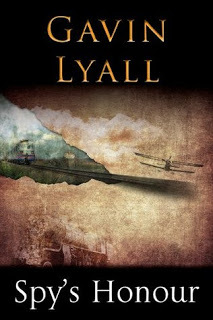
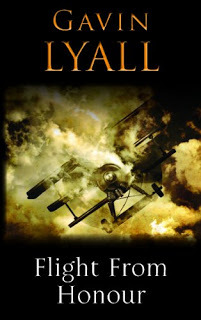
BRIT SPY—GAVIN LYALL I thought I told you when you joined the British Secret Service that Britain has no Secret Service...This quote is one of the many succinct points I’ve gotten a kick out of in this late career WW1 espionage tale, Spy’s Honour , from Gavin Lyall.
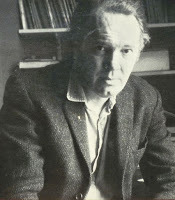 Originally making his mark as a High Adventure writer—with such great actioneers as Midnight Plus One, Venus With Pistol, The Wrong Side of the Sky, and Shooting Script—Lyall branched off in mid-career into Len Deighton/LeCarré territory. I was totally hooked on Lyall's early novels, but was disappointed when he changed genre directions.
Originally making his mark as a High Adventure writer—with such great actioneers as Midnight Plus One, Venus With Pistol, The Wrong Side of the Sky, and Shooting Script—Lyall branched off in mid-career into Len Deighton/LeCarré territory. I was totally hooked on Lyall's early novels, but was disappointed when he changed genre directions. 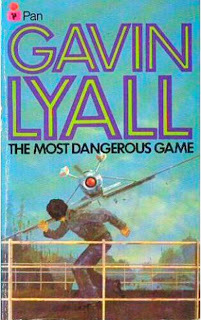 Lyall’s early books had a reputation for their believable aviation backgrounds and the driving first person narration of his everyman heroes. With the substitution of planes for horses, Lyall’s easy flowing prose was similar to Dick Francis’. His heroes were capable, but of questionable morality. They travelled through exotic or hostile locations in beaten-up aircraft, always trying to stay ahead of the law or the lawless.
Lyall’s early books had a reputation for their believable aviation backgrounds and the driving first person narration of his everyman heroes. With the substitution of planes for horses, Lyall’s easy flowing prose was similar to Dick Francis’. His heroes were capable, but of questionable morality. They travelled through exotic or hostile locations in beaten-up aircraft, always trying to stay ahead of the law or the lawless.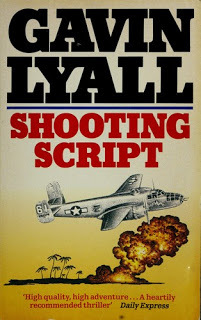 These thrillers established him at the top of the second tier of British thriller writers, behind Alistair MacLean, Desmond Bagley, and Hammond Innes. This was heady company as the British thriller writers of the time were the best in the world (still are as far as I’m concerned) and his books rubbed shoulders and sales with those of Colin Forbes, Victor Canning, John Gardner, the aforementioned Dick Francis, and many others.
These thrillers established him at the top of the second tier of British thriller writers, behind Alistair MacLean, Desmond Bagley, and Hammond Innes. This was heady company as the British thriller writers of the time were the best in the world (still are as far as I’m concerned) and his books rubbed shoulders and sales with those of Colin Forbes, Victor Canning, John Gardner, the aforementioned Dick Francis, and many others.However, after the last of these first person thrillers, Judas Country (1975), Lyall slipped into a five year funk of writer’s block. Hoping a different approach would break through his ennui, Lyall began writing the third person narratives of his Major Maxim series. Starting with The Secret Servant (1980), fans of Len Deighton and John LeCarré accepted Lyall as the new and popular voice of anti-Bond espionage fiction.
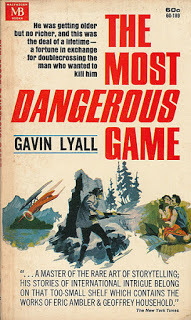 But there was a price for this new success. Gone were the fast paced plots and the sound of a plane’s choking coughs as its engine died somewhere above hostile territory. Gone were the clear through-lines rarely found in modern thrillers. Gone was the verve and tension which, as a former RAF pilot, Lyall brought to his descriptions of flying. But the biggest cost was the disappearance of his capable heroes who could get out of any jam as long as they had a spanner handy.
But there was a price for this new success. Gone were the fast paced plots and the sound of a plane’s choking coughs as its engine died somewhere above hostile territory. Gone were the clear through-lines rarely found in modern thrillers. Gone was the verve and tension which, as a former RAF pilot, Lyall brought to his descriptions of flying. But the biggest cost was the disappearance of his capable heroes who could get out of any jam as long as they had a spanner handy.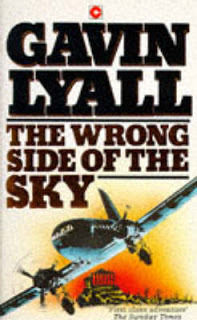 Major Harry Maxim was a British special forces officer working on secret assignments for the prime minister's office at 10 Downing Street. In theory, this sounded exciting, and the Maxim books were hitting the bestseller lists. However, I found them to be quicksand snoozers, and I dropped Lyall from my personal must read list of authors. I already struggled with LeCarré and Deighton’s miserable world view and bureaucratic maneuverings—none of which could match the suspense of Brit-TVs
The Sandbaggers
—and I didn’t need to add any more doorstop reading.
Major Harry Maxim was a British special forces officer working on secret assignments for the prime minister's office at 10 Downing Street. In theory, this sounded exciting, and the Maxim books were hitting the bestseller lists. However, I found them to be quicksand snoozers, and I dropped Lyall from my personal must read list of authors. I already struggled with LeCarré and Deighton’s miserable world view and bureaucratic maneuverings—none of which could match the suspense of Brit-TVs
The Sandbaggers
—and I didn’t need to add any more doorstop reading. 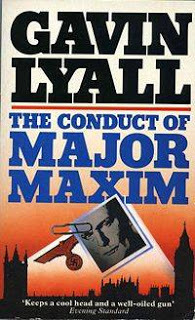 After publishing four novels detailing the machinations of Major Maxim, world events threw Lyall a curve—the Berlin Wall came crashing down, bringing an end to the Cold War so many espionage writers relied on to keep their plots topical. Depressed and drinking heavily (as so many writers of his generation did), Lyall fell into another deep funk of writers block.
After publishing four novels detailing the machinations of Major Maxim, world events threw Lyall a curve—the Berlin Wall came crashing down, bringing an end to the Cold War so many espionage writers relied on to keep their plots topical. Depressed and drinking heavily (as so many writers of his generation did), Lyall fell into another deep funk of writers block.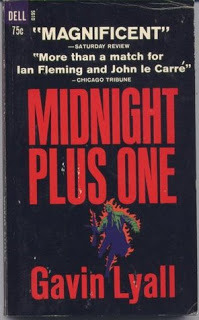 The third act of Lyall’s writing career came five years later in 1993. Supposedly retired, Lyall began writing a novel about the beginnings of the British Secret Service prior to World War I. The historical ground here was stripped down to basics. The world of espionage was only beginning to understand the dirty dealing, treacherous, unethical demands soon to be placed upon it as years progressed.
The third act of Lyall’s writing career came five years later in 1993. Supposedly retired, Lyall began writing a novel about the beginnings of the British Secret Service prior to World War I. The historical ground here was stripped down to basics. The world of espionage was only beginning to understand the dirty dealing, treacherous, unethical demands soon to be placed upon it as years progressed. For the first time in years, Lyall’s original thriller writer instincts began to kick in. Back was Lyall’s sense of adventure along with his morally ambiguous, yet identifiable characters. Disgraced British officer, Matthew Ranklin, reduced to being a mercenary in the Greek army finds himself unwillingly blackmailed into the employ of a budding British intelligence unit—the existence of which is denied at every level of government.
 Inexperience, naïve, and armed only with a two shot derringer taped below his left knee, Ranklin’s first assignment is to capture or kill an Irish anarchist who is chasing an Admiralty gold shipment worth twenty thousand pounds. Along the way, circumstances compel Ranklin to join forces with the spirited and devious Irish Nationalist, Conall O'Gilroy. This is a partnership of convenience at first, but it quickly becomes something deeper.
Inexperience, naïve, and armed only with a two shot derringer taped below his left knee, Ranklin’s first assignment is to capture or kill an Irish anarchist who is chasing an Admiralty gold shipment worth twenty thousand pounds. Along the way, circumstances compel Ranklin to join forces with the spirited and devious Irish Nationalist, Conall O'Gilroy. This is a partnership of convenience at first, but it quickly becomes something deeper.  The first novel in the new quartet, Spy’s Honor, is a loosely connected collection of four stories. Each details the bonding of Ranklin and O’Gilroy as they take on not only the enemies of the empire, but also the enemies within the bureaucracy of the British government. In their second outing,
Flight From Honour
, Rankin and O’Gilroy encounter American ‘enchantress' Corinna Finn, who steps in to save them when the duo run afoul of a French Royalist. The pair quickly becomes a trio and the team is complete.
The first novel in the new quartet, Spy’s Honor, is a loosely connected collection of four stories. Each details the bonding of Ranklin and O’Gilroy as they take on not only the enemies of the empire, but also the enemies within the bureaucracy of the British government. In their second outing,
Flight From Honour
, Rankin and O’Gilroy encounter American ‘enchantress' Corinna Finn, who steps in to save them when the duo run afoul of a French Royalist. The pair quickly becomes a trio and the team is complete.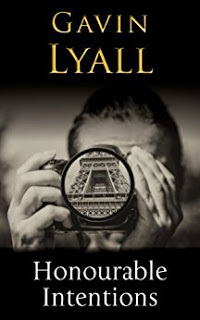 Two more adventures followed,
All Honourable Men
and
Honourable Intentions
, rounding out the quartet. While Lyall’s publisher dropped the ball in promoting these novels on the appropriate scale to turn them into bestsellers, they contain a level of readability much closer to Lyall’s original thrillers than the stodgy (if bestselling) espionage novels of the second act of his career. Lyall passed away in 2003, four years after the publication of the last book in this series.
Two more adventures followed,
All Honourable Men
and
Honourable Intentions
, rounding out the quartet. While Lyall’s publisher dropped the ball in promoting these novels on the appropriate scale to turn them into bestsellers, they contain a level of readability much closer to Lyall’s original thrillers than the stodgy (if bestselling) espionage novels of the second act of his career. Lyall passed away in 2003, four years after the publication of the last book in this series.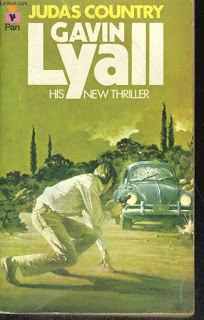 When Spy’s Honourwas recently recommended to me, I remembered fondly my delight with Lyall’s early books. As I was in the mood for a change of pace, I decided to give it a try. The WWI setting was unusual, and going back to the roots of the British Secret Service gave the narrative a true Sandbaggersappeal. The odd partnership of the main characters, even as a trio, reminded me of two of my favorite spies, Calder and Behrens, created for a series of short stories by Michael Gilbert (collected as
Mr. Calder and Mr. Behrens
and
Game Without Rules
).
When Spy’s Honourwas recently recommended to me, I remembered fondly my delight with Lyall’s early books. As I was in the mood for a change of pace, I decided to give it a try. The WWI setting was unusual, and going back to the roots of the British Secret Service gave the narrative a true Sandbaggersappeal. The odd partnership of the main characters, even as a trio, reminded me of two of my favorite spies, Calder and Behrens, created for a series of short stories by Michael Gilbert (collected as
Mr. Calder and Mr. Behrens
and
Game Without Rules
).I wasn’t halfway through Spy’s Honour when I hit up Amazon to download the three other books in what is known as the Honour Quartet. While these books have been available for a number of years, they are new to me, and it’s a joy to be reading new books from one of my favorite authors again.
********In a post about Gavin Lyall on the terrific Existential Ennui blog, I found the below two page letter from Gavin Lyall to author Rowland Ryder about the publishing business to present a unique insight into the writing business.
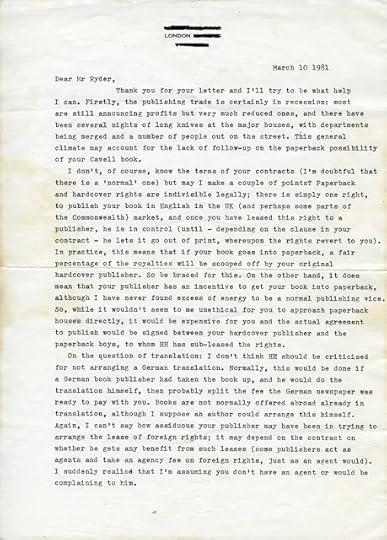
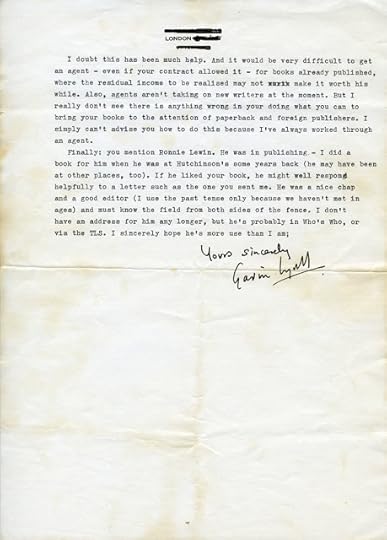
Published on July 04, 2017 12:50
July 3, 2017
NOT SO DISPICABLE
 NOT SO DISPICABLE After three viewing disappointments in a row (two previously reviewed movies and, a highly anticipate TV show season finale (yes, I'm also looking at you season 3 Fargo), Despicable Me 3 was good natured entertainment. Ultimately dispensable, but pleasant, inventive, and gently humorous. If you like this type of film, Despicable Me 3 is worth your time and ticket money...
NOT SO DISPICABLE After three viewing disappointments in a row (two previously reviewed movies and, a highly anticipate TV show season finale (yes, I'm also looking at you season 3 Fargo), Despicable Me 3 was good natured entertainment. Ultimately dispensable, but pleasant, inventive, and gently humorous. If you like this type of film, Despicable Me 3 is worth your time and ticket money...
Published on July 03, 2017 22:42
July 2, 2017
WE NEED A HERO
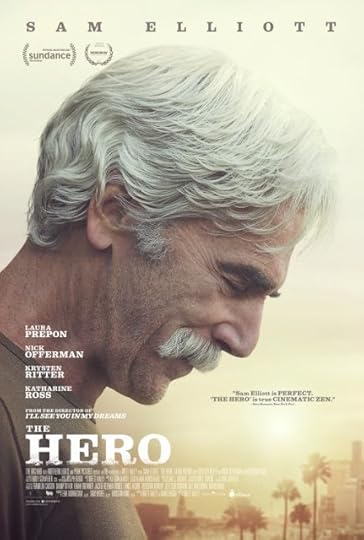 WE NEED A HERO
WE NEED A HEROAfter seeing the movie trailer, I had high hopes for The Hero starring Sam Elliott. I’ve been a Sam Elliott fan since his early western roles—his laconic presence, the gunsight eyes, The Voice. Now in his early 70s, The Hero looked tailor made for him. All of which found me in a seat the night it opened in our local art theatre. Five hours later—at least it seemed like five hours in the same way an hour can seem like five when you are in the dentist chair having your teeth drilled—I staggered into the light of the theatre lobby with crushed hopes and a bad stink in my nostrils.
Don’t get me wrong, Sam Elliott’s performance is excellent, but the scenes where the story makes progress can’t have taken up more than ten minutes of the film’s two hour running time. The other hour and fifty minutes moves at the pace of a retreating turtle—a silent twenty second close up of Sam’s face...a silent twenty second close up of the back of Sam’s head...a silent twenty second close up of the stray tribble that ate Sam’s upper lip...a silent twenty second close up of Sam’s neck—all of which does nothing more than give you a chance to realize Sam Elliott has been ridden hard and put away wet a whole bunch of times during his life. Sam has taken the term weathered to a whole new level. Trust me, Sam’s profile on the movie poster has been air brushed to within an inch of its life.
The rest of the story? It’s actually a reboot of those ‘80s drug warning commercials—You remember those, right? A picture of a pristine egg appears with a voice over claiming, This is your brain. Then there’s a picture of an egg bubbling, frying, and burning around the edges in a frying pan with a voice over saying, This is your brain on drugs. The Hero updates this message to play out as—This is Sam Elliott after years of alcohol abuse and smoking a container ship’s worth of the Devil’s lettuce. Watch Sam slowly and silently roll and smoke a joint...Watch Sam silently roll and smoke another joint...Watch Sam ingest enough shrooms to send an entire Indian tribe on a vision quest...Watch Sam mix molly and champagne and ingest it like a shot of tequila.
What is there to like about the film? Sam Elliott still has a certain cowboy charm and The Voice still resonates. Otherwise, it’s a bigger miss on the entertainment scale than the last film I wasted my ticket money on—Paris Can Wait. Sam Elliott will certainly have to wait for an actual career defining film no matter what the critics are saying about this one.
Published on July 02, 2017 09:14



